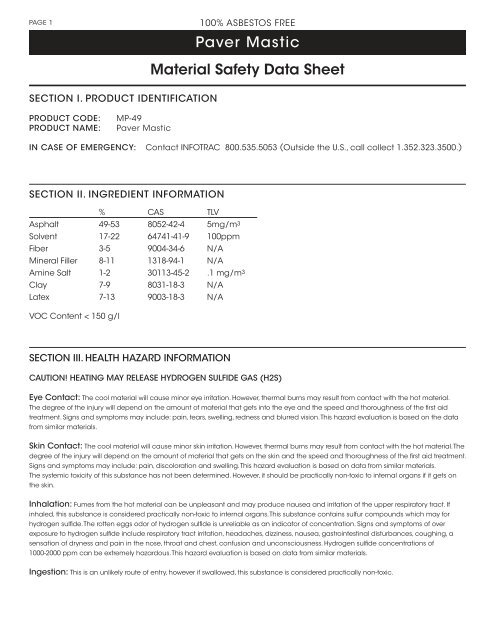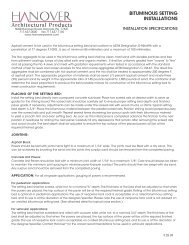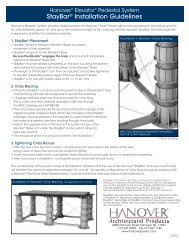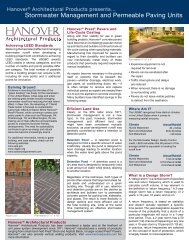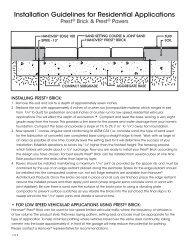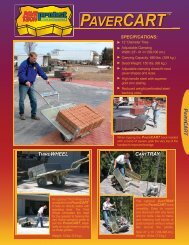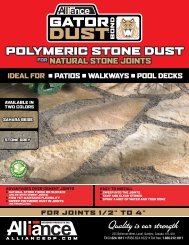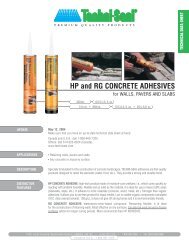Paver Mastic Material Safety Data Sheet - Hanover® Architectural ...
Paver Mastic Material Safety Data Sheet - Hanover® Architectural ...
Paver Mastic Material Safety Data Sheet - Hanover® Architectural ...
You also want an ePaper? Increase the reach of your titles
YUMPU automatically turns print PDFs into web optimized ePapers that Google loves.
PAGE 1<br />
SECTION I. PRODUCT IDENTIFICATION<br />
PRODUCT CODE: MP-49<br />
PRODUCT NAME: <strong>Paver</strong> <strong>Mastic</strong><br />
100% ASBESTOS FREE<br />
<strong>Paver</strong> <strong>Mastic</strong><br />
<strong>Material</strong> <strong>Safety</strong> <strong>Data</strong> <strong>Sheet</strong><br />
IN CASE OF EMERGENCY: Contact InFOTRAC 800.535.5053 (Outside the U.S., call collect 1.352.323.3500.)<br />
SECTION II. INGREDIENT INFORMATION<br />
Asphalt<br />
Solvent<br />
Fiber<br />
Mineral Filler<br />
Amine Salt<br />
Clay<br />
Latex<br />
%<br />
49-53<br />
17-22<br />
3-5<br />
8-11<br />
1-2<br />
7-9<br />
7-13<br />
VOC Content < 150 g/l<br />
CAS<br />
8052-42-4<br />
64741-41-9<br />
9004-34-6<br />
1318-94-1<br />
30113-45-2<br />
8031-18-3<br />
9003-18-3<br />
SECTION III. HEALTH HAZARD INFORMATION<br />
CAUTION! HEATING MAY RELEASE HYDROGEN SULFIDE GAS (H2S)<br />
TLV<br />
5mg/m 3<br />
100ppm<br />
n/A<br />
n/A<br />
.1 mg/m3 n/A<br />
n/A<br />
Eye Contact: The cool material will cause minor eye irritation. However, thermal burns may result from contact with the hot material.<br />
The degree of the injury will depend on the amount of material that gets into the eye and the speed and thoroughness of the first aid<br />
treatment. Signs and symptoms may include: pain, tears, swelling, redness and blurred vision. This hazard evaluation is based on the data<br />
from similar materials.<br />
Skin Contact: The cool material will cause minor skin irritation. However, thermal burns may result from contact with the hot material. The<br />
degree of the injury will depend on the amount of material that gets on the skin and the speed and thoroughness of the first aid treatment.<br />
Signs and symptoms may include: pain, discoloration and swelling. This hazard evaluation is based on data from similar materials.<br />
The systemic toxicity of this substance has not been determined. However, it should be practically non-toxic to internal organs if it gets on<br />
the skin.<br />
Inhalation: Fumes from the hot material can be unpleasant and may produce nausea and irritation of the upper respiratory tract. If<br />
inhaled, this substance is considered practically non-toxic to internal organs. This substance contains sulfur compounds which may for<br />
hydrogen sulfide. The rotten eggs odor of hydrogen sulfide is unreliable as an indicator of concentration. Signs and symptoms of over<br />
exposure to hydrogen sulfide include respiratory tract irritation, headaches, dizziness, nausea, gastrointestinal disturbances, coughing, a<br />
sensation of dryness and pain in the nose, throat and chest, confusion and unconsciousness. Hydrogen sulfide concentrations of<br />
1000-2000 ppm can be extremely hazardous. This hazard evaluation is based on data from similar materials.<br />
Ingestion: This is an unlikely route of entry, however if swallowed, this substance is considered practically non-toxic.
PAGE 2<br />
Additional Health <strong>Data</strong> Comment: Studies in which mice were exposed to a variety of whole asphalts did not result in any<br />
increased cancer rate; mice exposed to asphalts diluted with hydrocarbon solvents had increased incidence of certain types of cancer.<br />
Brief or intermittent skin contact with this asphalt product is not expected to produce any delayed effects. While normal handling of this<br />
product is not likely to cause cancer in humans, skin contact and breathing of mists or vapors should be reduced to a minimum.<br />
This product contains clay which contains crystalline silica. Crystalline silica has been listed as a carcinogen by IARC, however, the particles<br />
are coated with asphalt and are not available for inhalation. As such, there is little or no chance of inhalation of crystalline silica and<br />
resultant diseases.<br />
FIRST AID:<br />
Eye Contact: Flush eyes, including under eyelids, with running water for at least fifteen minutes. Get medical attention.<br />
Skin Contact: If the hot, melted material gets on the skin, quickly cool in water. See a doctor for extensive burns. DO nOT try to peel the<br />
solidified material from the skin or use solvents or thinners to dissolve it. The use of vegetable oil or mineral oil is recommended for removal<br />
of this material from the skin. Flush exposed area with water while removing contaminated clothing. Get medical attention if irritation<br />
persists.<br />
Inhalation: If there are signs or symptoms of hydrogen sulfide exposure (respiratory tract irritation, headache, dizziness, nausea,<br />
gastrointestinal disturbances, coughing, a sensation of dryness and pain in the nose, throat and chest, confusion and unconsciousness),<br />
move the person to fresh air. If breathing has stopped, apply artificial respiration. Call a doctor. note to physician: In addition to use of<br />
100% oxygen and supportive care, suggested treatment for hydrogen sulfide poisoning includes the use of nitrites. This is based on similar<br />
mechanisms of toxicity between hydrogen sulfide and hydrogen cyanide. The nitrite-induced methemoglobin is thought to bind the toxic<br />
hydrosulfide ion. Initial inhalation of amyl nitrite pearls for 15 to 30 seconds if each minute should be initiated until 10 ml of a 3% solution of<br />
sodium nitrite can be administered intravenously at 2.5 to 5 ml per minute. While the efficacy of nitrites in hydrogen sulfide poisoning has<br />
not been unequivocally demonstrated, their use is recommended as part of the treatment regimen. Hyperbaric oxygen therapy has been<br />
used for cyanide poisoning with some success and may be of benefit in hydrogen sulfide poisoning if other measures are ineffective.<br />
Ingestion: Unlikely, if occurs give person milk or water. Keep head below the waist. Contact physician or Poison Control Center. never give<br />
anything by mouth to a person who is unconsciousness or is having convulsions.<br />
NFPA RATING: HEALTH - 1 FIRE - 1 REACTIVITY - 0<br />
SECTION IV. FIRE AND EXPLOSION DATA<br />
FLASH POINT AND METHOD: ~110ºF<br />
UPPER EXPLOSIVE LIMIT: n/A<br />
LOWER EXPLOSIVE LIMIT: n/A<br />
Extinguishing Media: Water, carbon dioxide and dry chemical. Us e water spray to cool fire-exposed containers. A fine water mist may<br />
be used to smother fire or to disperse vapors. Do not use a solid stream of water since the stream will scatter and spread the fire.<br />
Fire fighters must wear self-contained breathing apparatus and full protective clothing when fighting fires involving this material.<br />
SECTION V. REACTIVITY DATA<br />
CAUTION! HEATING MAY RELEASE HYDROGEN SULFIDE GAS (H2S)<br />
This material is stable in closed containers at room temperature under normal storage and handling conditions. It does not polymerize. It is<br />
compatible with strong oxidizing agents. Decomposition products can include carbon monoxide, carbon dioxide, and water vapor.<br />
SECTION VI. PHYSICAL DATA<br />
BOILING POINT: ~650ºF<br />
APPEARANCE AND ODOR: Black liquid with organic odor
PAGE 3<br />
SECTION VII. SPILL, LEAK AND DISPOSAL PROCEDURE<br />
notify safety personnel of large spills or leaks. Clean-up personnel need protection against liquid contact and vapor inhalation. Absorb<br />
small spills and collect liquid, if feasible, or absorb with vermiculite or sand. Do not flush to sewer or stream.<br />
Dispose of liquid waste via licensed waste disposal company. Follow Federal, State and Local regulations.<br />
SECTION VIII. SPECIAL PROTECTION INFORMATION<br />
Wear impervious gloves and safety glasses to prevent contact with the skin and eyes. If repeated or prolonged contact with liquid is likely,<br />
wear protective clothing including boots, apron, and faceshield or splash goggles. Remove contaminated clothing immediately and do<br />
not reuse until it has been properly laundered. Eye wash stations and safety showers should be available in use and handling areas.<br />
Contact lenses pose a special hazard; soft lenses may absorb and all lenses concentrate irritants.<br />
SECTION IX. SPECIAL PRECAUTIONS AND COMMENTS<br />
Store in closed containers in a cool, dry, and well-ventilated area away from oxidizers, heat and open flame. Protect containers from<br />
physical damage.<br />
5000 Hanover Road, Hanover, PA 17331<br />
717.637.0500 • fax 717.637.7145<br />
www.hanoverpavers.com<br />
2-8-08


